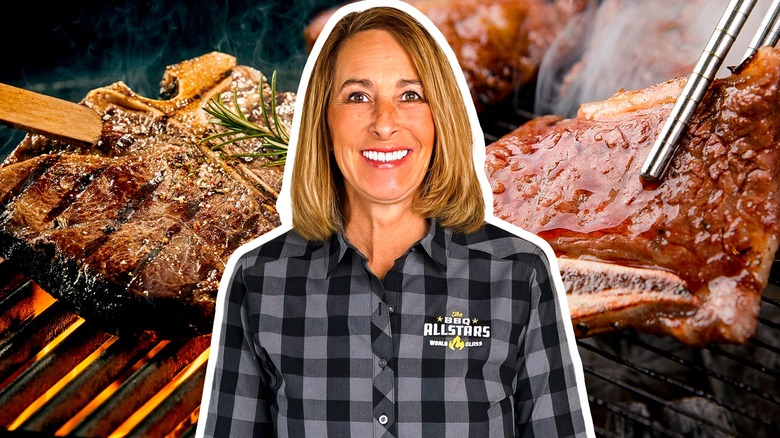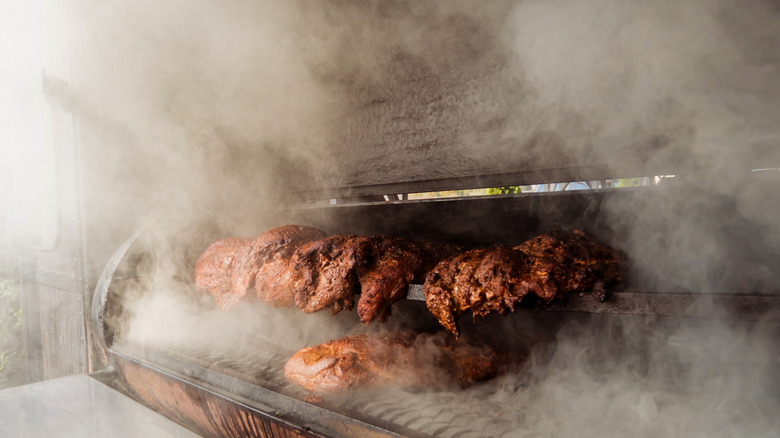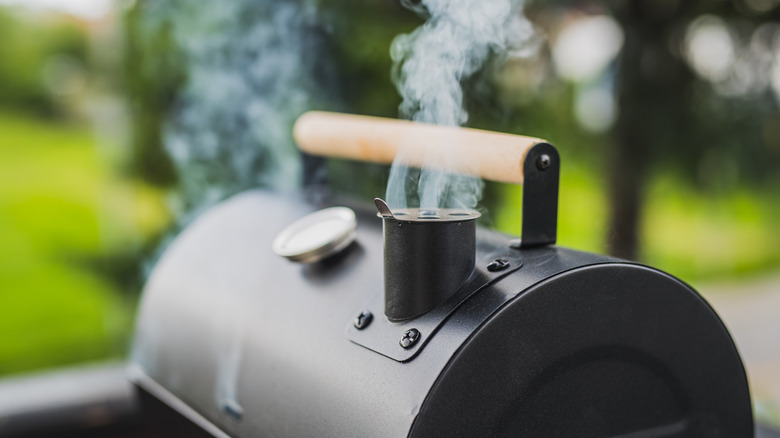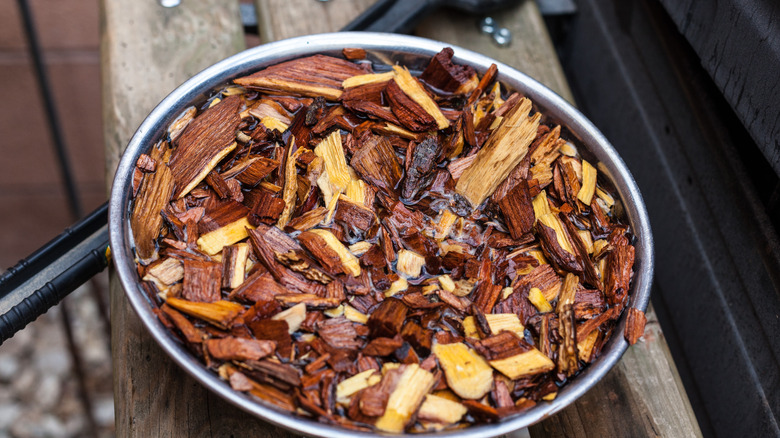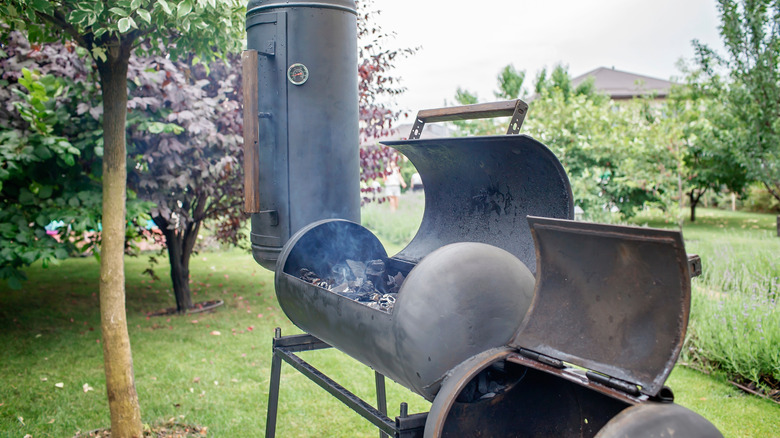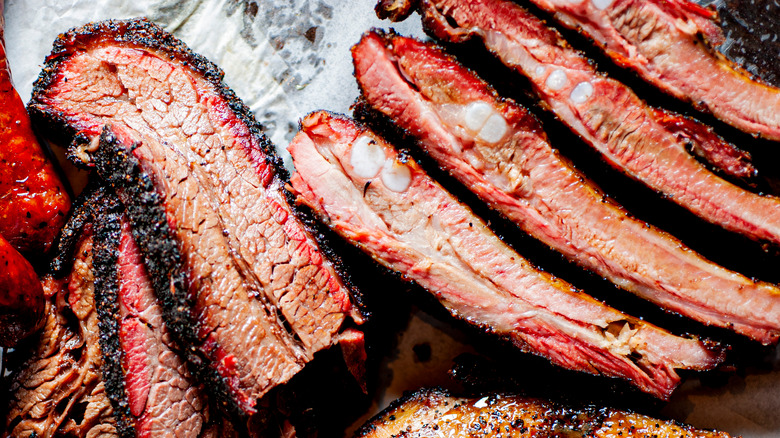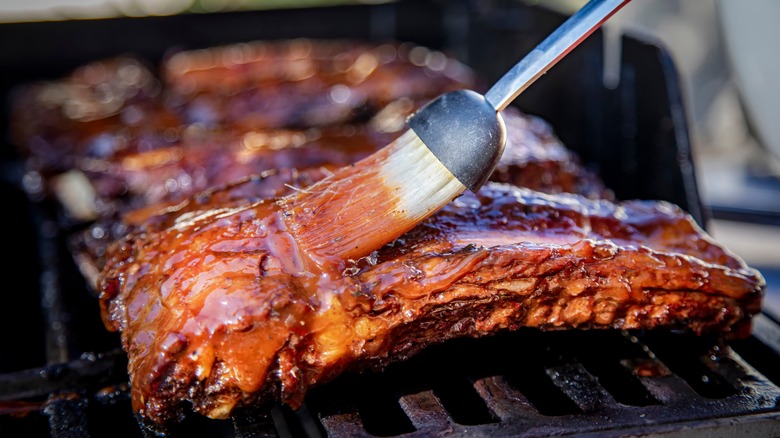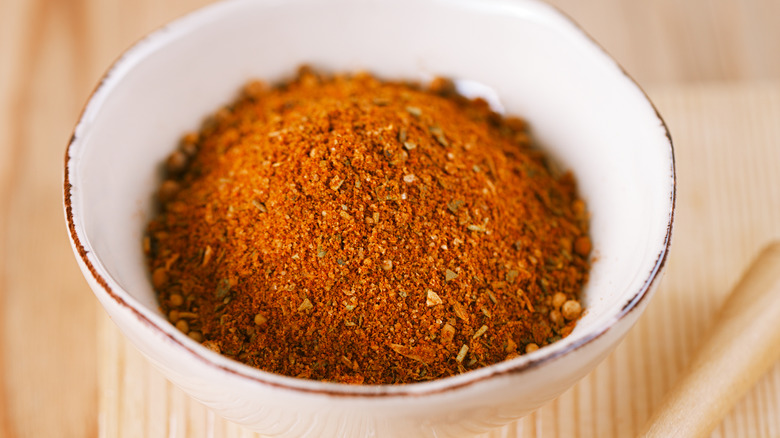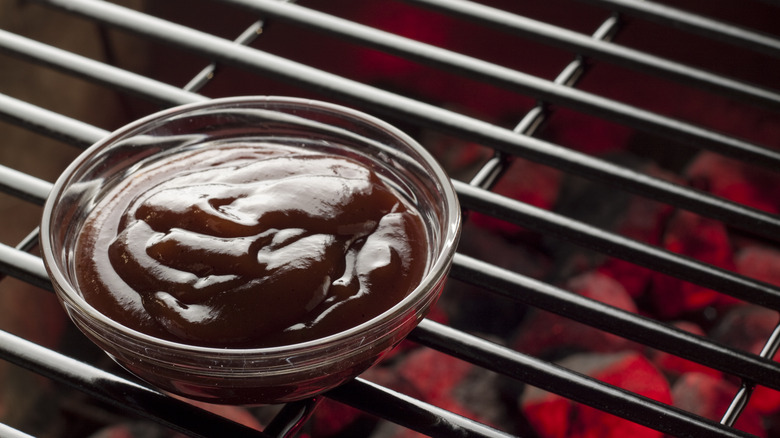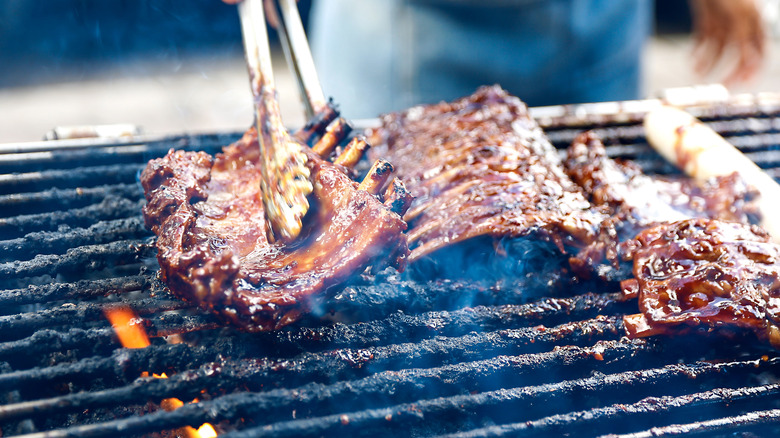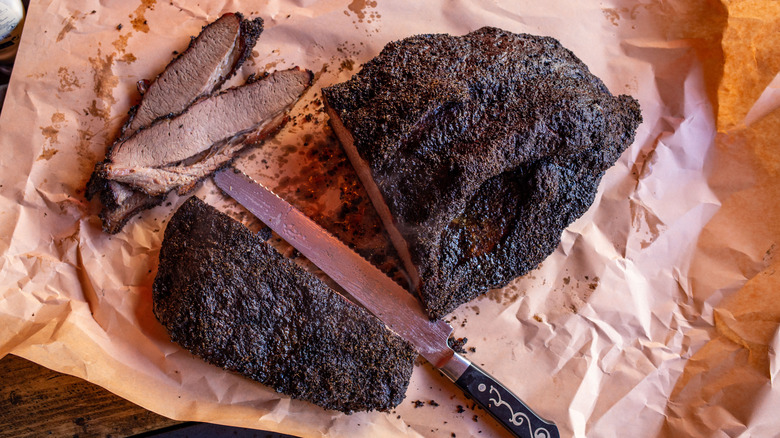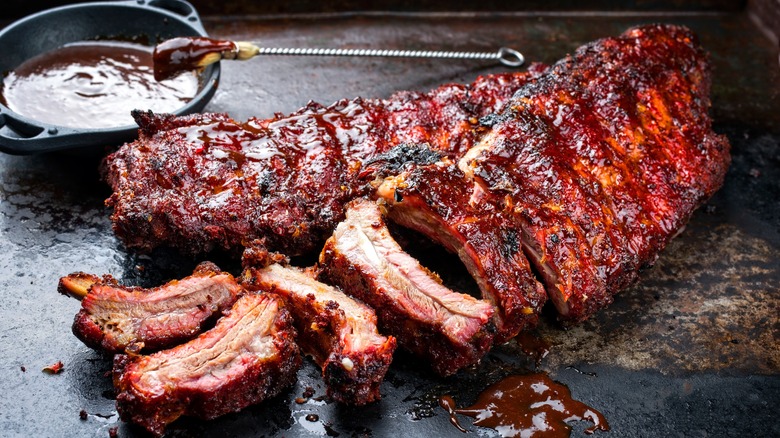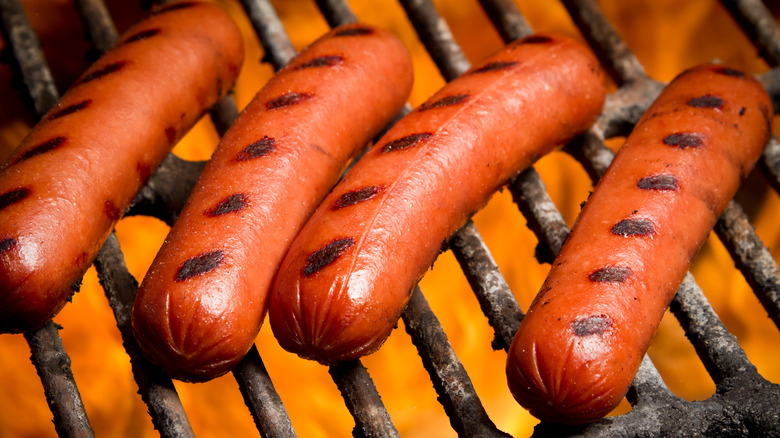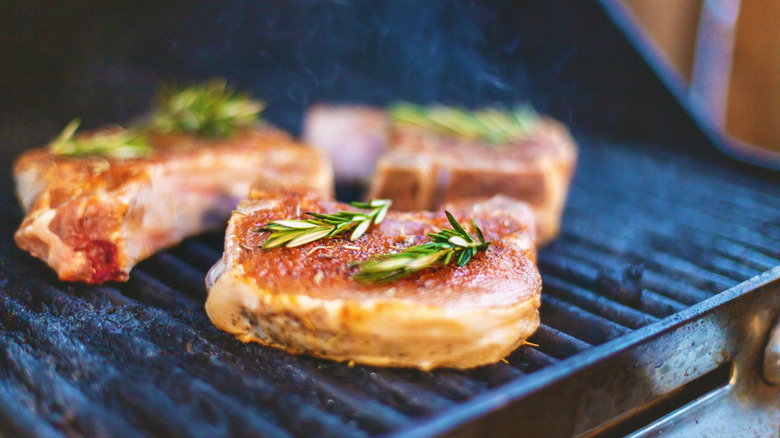14 Bbq Myths You Can Stop Believing, According To World Barbecue Champion Melissa Cookston
The world of barbecue is filled with folk wisdom and accepted truths, and it's easy to be afraid that you're doing it wrong. But not every oft-repeated do's and dont's holds water. In fact, a lot of the accepted truths about making barbecue are dead wrong.
Fortunately, we're here to help bust these pernicious barbecue myths, and we've enlisted the help of a real expert: Melissa Cookston, a cookbook author, restaurant owner, and seven-time world barbecue champion. Melissa recently returned to TV as one of the judges of Netflix's "Barbecue Showdown." The second season premiered May 22, and Cookston says the competition is hotter than ever. "This group of contestants is fantastic ... Just to watch them develop over the days of rigorous cooking is so fun." The new season also features a new and fearsome cooking apparatus known simply as "The Trench."
In an exclusive interview with Tasting Table, Cookston separated smoking and grilling fact from barbecue fiction. These are 14 barbecue myths that just don't stand up to scrutiny.
1. More smoke is better
The purpose of barbecuing meat is to make it taste smoky, so it might seem like you should try to maximize that flavor at all costs. Not so, says Cookston — when it comes to smoke, there's a real danger of having too much of a good thing. "I think the most common misconception is that when you're smoking meat, you need to over-smoke meat," she says.
No matter the context, cooking great meals is all about balancing flavors. When you're cooking inside, you need to stay mindful about balancing spice, acidity, umami, and any other taste components of the dish you're making. Too much of one flavor makes everything out of whack. The same holds true when barbecuing, with smokiness just being another seasoning you can manipulate to create the best results. As Cookston puts it, you should "treat smoke like any other ingredient. You don't want to oversalt your food so don't over-smoke your food either."
2. You can use one type of wood for all meat
Ask four barbecue enthusiasts about the best wood for smoking meat and you'll likely get four different answers. Regional barbecue styles can sometimes be classified according to which woods are traditionally used, but beginner smokers are often advised to start with one wood for everything. Depending on the source you consult, oak, hickory, or fruit woods may be recommended as all-purpose solutions for people learning how to make barbecue.
Cookston disagrees with this approach because it goes against her precept that smoke should be used like an ingredient. Certain woods put out more smoke flavor than others, and certain meats taste better with more smoke. "If you have white meats like chicken or pork you need to use lighter woods for smoking," notes Cookston. In those cases, she recommends fruit woods such as apple, cherry, or peach. "If you are cooking red meat," she adds, "then you can work with a little harsher wood like hickory."
3. Meat continues to get smokier the longer it's on the fire
Barbecuing can be an unintuitive process, and this myth is one example. It seems apparent that you could control the level of smoke flavor in your meat by how long you choose to leave it on the smoker, but Cookston says that meat stops absorbing smoke long before it's fully cooked. "Once meat reaches an internal temperature of around 100 degrees Fahrenheit, it really doesn't take much more smoke — those pores close up," she says. Smoked brisket isn't done until it reaches around 200 degrees, so that means a large portion of the time the meat's in the smoker, it's not getting any smokier. This is why wood choice is so important — it will have a bigger effect on flavor than the duration of the smoke.
This means that, in theory, you could start meats on a smoker and then transfer them to a low oven once they've taken on all the smoke flavor they can and achieve similar results as you would if you smoked them the whole time. However, this is not Cookston's method of choice. "If I'm smoking a whole hog, I'm putting wood to it for 20 hours."
4. You should soak wood before adding it to the smoker
Many barbecue resources tell you to soak the wood you use for smoking in water before you cook, especially if you're working with wood chips. The reasoning behind this is that soaking will theoretically make the chips burn more slowly, which means you won't have to add fresh chips as often during the cooking process.
Soaking chips would be great if it worked, but Cookston doesn't recommend the technique. She told us, "When you soak wood, it really won't smoke until it's dry ... soaking wood is really kind of a misconception." Rather than giving you a long, controlled burn, soaked chips merely steam until they finally catch fire. During the steaming process, they're not imparting any smoke flavor to your meat. Fortunately, there is a strategy that actually works if you want to add wood less frequently: smoke over larger chunks of wood. They will burn longer and won't need to be replaced quickly.
5. You need a fancy smoker to make real barbecue
As with any hobby, barbecuing has a whole industry set up to try to sell you gear that promises to make your life easy and your meats come out perfect. If you want to, you can spend as much as you would on a car for a tricked-out stainless steel smoker with computerized temperature control and automatic fuel feeding.
These luxury smoking rigs may indeed make smoking meat a little easier, but they're far from necessary. In fact, according to Cookston with the right know-how, you can make excellent barbecue on a Weber kettle grill that only costs a little over $100. "I think you just have to know your equipment and treat each piece of equipment for what it's designed for," she says. "It depends on your cooking level, but it's very easy to use a Weber with a two-zone fire and do long cook times on it."
That said, Cookston isn't immune from the temptations of fancy gear. "I have 36 different grills and smokers and they all have their own personality." Trying out various smokers can be fun, but don't let having limited equipment or budget stop you from trying to smoke your own meat.
6. A smoke ring indicates quality
A smoke ring is the pink border that often shows up in slices of smoked meat. While it's often held up as an indicator of quality barbecue — a bigger smoke ring should intuitively mean more smoke flavor — the smoke ring isn't as important as you think.
The pink ring around a piece of barbecue is created by a chemical reaction between the nitric oxide in smoke and the myoglobin in meat (which is a red-colored protein). Myoglobin typically turns brown when meat cooks, but nitric oxide halts this process, preserving the meat's pink color. But the equation isn't as simple as more smoke ring equals more smoke taste. Depending on the specific temperature you choose to cook at, you may encourage or discourage smoke ring formation. Certain woods have more nitric oxide, leading to pinker meat. Keeping the surface of the meat moist also gives you a bigger ring. This all adds up to the fact that you can create really smoky meat without producing much of a smoke ring at all.
Cookston knows this, and that's why she doesn't pay much attention to smoke rings when she judges barbecue. "When you're judging, you judge the appearance of meat, and I don't think it's imperative to have a smoke ring in order to have a great appearance."
7. Basting is necessary for moist meat
Certain barbecue preparations call for basting, mopping, or spritzing with some type of flavorful liquid during the cooking process. Not only does this add flavor, but it's supposed to make meat more moist and promote a big smoke ring as well. While Cookston isn't opposed to basting, it isn't part of her repertoire. "I'm not a purist," she admits. "I think there are a lot of ways to achieve great barbecue. It just happens that those are not my methods."
Cookston eschews basting in favor of other strategies for adding moisture to her barbecue, including injecting her meats with broth before cooking. "You baste and spritz to add flavor or moisture, and I depend on my injections or rubs for that."
One way that Cookston's injections may be superior to basting is that they don't require you to open the lid of your smoker regularly to apply liquid. "If you're opening that door you're losing all your heat, which you have to gain back," she notes. "You get big temperature fluctuations that way which, when you're rendering fats and collagens, is bad for the cooking process."
8. You can use an all-purpose barbecue rub
There are a nigh-infinite number of so-called "all-purpose barbecue rub" recipes online that purport to work for seasoning any type of meat you want to smoke, be that pork, poultry, beef, or lamb. They might be okay in all of those contexts, but any general-purpose barbecue rub is inherently going to be a jack of all trades, master of none.
The same as she does with wood, Cookston likes to tailor her seasoning mixes to the specific meats she's preparing. Different proteins obviously have different flavors, so it doesn't make sense to season them with a one-size-fits-all approach. "Pork and chicken are delicate meats, and just like smoke, you don't want to have any forward flavors," Cookston says. "You need a well-balanced flavor, so I try to get a little sweet, a little salty, a little umami, maybe a little heat in the back. Red meats will accept a little heavier flavor, so I'll add some coarse salt and cracked black pepper."
9. Meat needs barbecue sauce for flavor
In some quarters, barbecue sauce is synonymous with the flavor of barbecue. Many of us grew up eating barbecue chicken that wasn't cooked on a grill or smoker at all — instead, it was simply slathered with plenty of sticky sauce. While oven-baked barbecue chicken is quite tasty, for Cookston, the essence of barbecue is in cooking over an open flame, and she doesn't think that sauce is strictly necessary for smoked meats. Despite this, she still serves barbecue sauce with her meat. "I think Americans as a whole are condiment people, so I think it's important to give options," she says.
While Cookston has very specific ideas about the types of woods and rubs to pair with specific meats, sauce choice comes down much more to the individual preferences of diners. "Moving from chicken to pork to beef, I think we like what we like ... barbecue is very personal," she reveals. "What you grew up on, thinking 'this is good barbecue,' that's what you'll gravitate to."
10. Memphis-style barbecue is dry-rub only
It's fun to read about different variations of regional barbecue to get inspiration for your own recipes or plan food pilgrimages, but you shouldn't believe everything you see online (unless it's on Tasting Table, of course). For example, some resources claim that Memphis-style barbecue uses a dry rub with no sauce, but Cookston insists that's dead wrong. She should know — her restaurant is called the Memphis Barbecue Company and it's located in Horn Lake, Mississippi, a community on the outskirts of Memphis.
"There's one restaurant in Memphis that serves dry ribs, but the region itself does wet barbecue," explains Cookston. "We may cook the sauce down on the meat for 10 or 15 minutes, but we like sauced ribs." At her restaurant, you can order sauced, unsauced, or "muddy" ribs coated in a mixture of sauce and rub. You're free to choose what you want, but if you're trying to make ribs the way the majority of Memphians eat them, you should lacquer them with sauce.
11. Wrapping meat is cheating
When smoking a large piece of meat like a brisket, the internal temperature tends to increase at a regular rate until it reaches around 165 degrees Fahrenheit. Then, all of a sudden, it stops getting hotter and the internal temperature plateaus for up to six hours before it starts rising. In barbecue circles, this phenomenon is known as "the stall," and it seriously increases the amount of time it takes to smoke large cuts of meat. The stall happens because moisture evaporating from the beef begins to drop its temperature at the same rate your smoker is heating it up — it cools off the brisket in the same way sweat cools you off on a hot day.
The old-school method is to just power through the stall, as eventually evaporation will slow and allow the meat to begin cooking again. Old-time pitmasters may view any deviation from this method as cheating, but these days, it's popular to wrap the meat in foil or butcher paper once it reaches the stall point. This prevents evaporation and creates a moist braising environment that finishes cooking the meat relatively quickly.
Cookston embraces wrapping, as it not only means her meat finishes cooking at a predictable time but also gives her an opportunity to add more moisture and flavor inside the wrap. She goes with butcher paper over foil because it breathes, unlike foil, which makes a watertight seal.
12. Meat should be cooked until it falls off the bone
Falling off the bone is often talked about as a desirable trait for meat. That may be true of a braise or a stew, but in Cookston's view, that's just too soft for barbecue. "Mouthfeel is very important when you're eating barbecue," she says. "If it falls off the bone it can tend to be a little overcooked on the palate." She describes the optimal temperature for barbecue as "a few degrees back from falling off the bone."
Cookston associates that extra-soft texture with parboiling ribs before putting them on the grill, which is not a method she recommends. "I'm not a purist, so if people say that's good barbecue, then I'm going to agree with them," Cookston notes. "I won't eat it, but I'm not going to pick on you for eating it." Parboiling ribs can certainly be a fast, convenient way to make them soft enough to eat, but if you want to make championship-level barbecue like Melissa Cookston, the ribs need to be cooked from start to finish on a smoker.
13. Grilling isn't barbecue
Barbecue purists often claim that grilling and barbecue are two different things entirely — cooking over high heat is grilling, while barbecue involves slow, indirect smoking. By this definition, anyone who calls it "a backyard barbecue" when they gather some friends together and throw hot dogs and burgers on a fire is using the wrong terminology. But in keeping with her general anti-purist stance, Cookston has an inclusive definition of barbecue: "If you're cooking on fire, even if it's gas-assisted, that's barbecue ... Barbecue can be used as a noun, a verb, an adjective, or an adverb, but I think it's all-encompassing of a type of cooking with fire."
This opinion on the meaning of barbecue is in keeping with the origins of the word, which comes from the Spanish "barbacoa." The Spanish word, in turn, was borrowed from the indigenous peoples of the Caribbean, who used the term to describe a wooden device for cooking meat over a fire. This original barbecue could both smoke and grill meat. The next time a barbecue snob tells you burgers aren't barbecue, you can give them a history lesson.
14. Beginners should start small
When you're starting out on your barbecue journey, it might make sense to dip your toe in the water with smaller pieces of meat. A whole brisket or pork shoulder can seem intimidating, and if you screw it up it's a big waste. Indeed, it's easy to find guides for beginner pitmasters that say to start small with meats like salmon, pork chops, or duck. However, Cookston gives the opposite advice for beginners, suggesting, "If you can be patient, large cuts of meat are more forgiving, so try a pork butt or a brisket." Pork butt and brisket both contain a lot of fat and connective tissue that break down over long cooking, resulting in a juicy, soft texture and more margin for error. This isn't true of lean meats like pork chops, which can easily dry out.
But large cuts do require a big time commitment. Our smoked pulled pork recipe, which uses pork butt, takes around 10 hours from start to finish. Some of us can't wait that long, and Cookston thinks that's okay. "If you don't have the patience, then try smaller cuts, because they'll be ready more quickly," she says. "You'll get a result that you want much faster."
